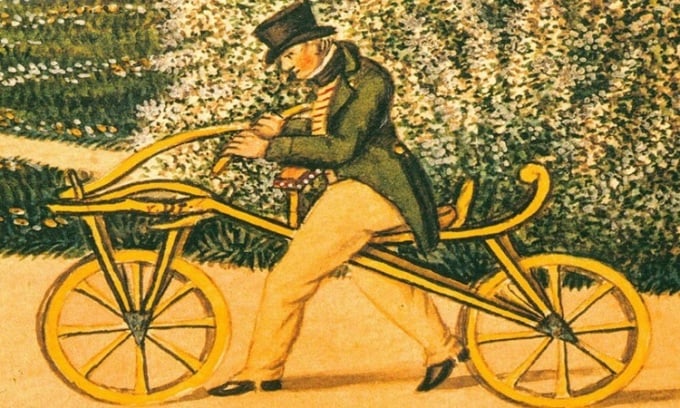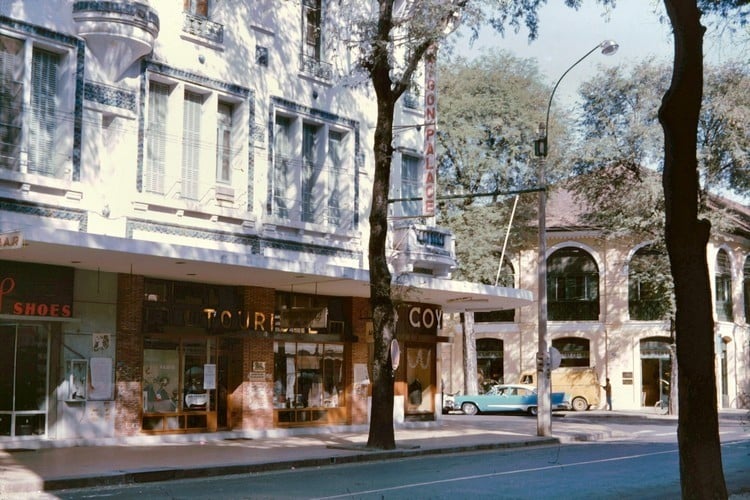The two-wheeled vehicle created by German inventor Karl von Drais caused a stir in many European countries in the early 19th century.

Replica of Karl von Drais' two-wheeled carriage. Photo: Amusing Planet
In April 1815, Mount Tambora on the island of Sumbawa in what is now Indonesia erupted with unprecedented force. A huge amount of rock fragments, weighing an estimated 10 billion tons, were shot into the atmosphere. These rock fragments and ash rose into the stratosphere and spread, covering the sky and blocking out sunlight for months. The eruption also released large amounts of sulfur dioxide into the atmosphere, leading to the formation of sulfate aerosols, which caused a significant cooling of the Earth’s surface temperature. The cold temperatures and altered weather patterns caused crop failures and famine in many parts of the world.
Scarcity of resources had a profound impact on daily life, making it impossible for many people to sustain traditional animals of transport such as horses and mules. In these difficult circumstances, Karl von Drais, a young German inventor, found the motivation to create a new form of transport that did not depend on horse power. This led to the creation of the world's first two-wheeled vehicle.
Von Drais's Laufmaschine consisted of two wheels placed in a straight line, similar to today's bicycles and motorcycles. The vehicle was made of wood, with a horizontal bar connecting the two spoked wooden wheels. A small leather seat was placed in the middle of the bar, providing a seat for the rider. A vertical shaft with a series of control rods connected to the front wheel served as steering. The vehicle was propelled entirely by the rider's own power. The rider would sit on the leather seat, press their feet against the ground, and move back and forth to gain momentum. Each pedal stroke would propel the vehicle farther than a person could walk.
On June 12, 1817, Von Drais set off from Mannheim along the most scenic roads to Baden in his Laufmaschine. Taking a southwesterly route, he traveled nearly 7 kilometers before arriving at a roadside inn called the Schwetzinger Relaishaus. While it is unclear whether Von Drais stopped at the inn to rest, historical records confirm that his round trip took just over an hour, less than half the time it would have taken to walk the same route from Mannheim to the inn and back.
Six months later, Von Drais applied for a patent in France and introduced the term vélocipède to describe his invention. The patent application was successful and the vehicle quickly attracted the attention of French society. Von Drais demonstrated the pioneering vehicle in several European capitals, attracting large audiences with its novel design and functionality, and generating many orders for the human-powered vehicle. Because Von Drais manufactured each component himself, delivery times were long, and the initial craze surrounding the vehicle faded in Europe by the end of that year. However, seeing the growing demand, many manufacturers in France and England sought to cash in on the popularity of the vélocipède by releasing their own versions. Of these, the version created by London chair maker Denis Johnson was considered the most practical.
Denis Johnson introduced several improvements to the two-wheeled vehicle he marketed in London. Most notably, Johnson's crossbar was lowered in the middle, allowing for larger wheels, which improved the ride quality. In addition, the steering mechanism was made of iron, which gave the driver greater control. At the same time, the incorporation of iron bands on the outer edges of the wheels also greatly increased their durability. Johnson's version quickly became popular by early 1819.
However, the trend of moving by this vehicle quickly encountered many obstacles such as rough roads, frequent passing rickshaws, posing a challenge in maintaining balance. Some daredevils even drove on the sidewalk, endangering pedestrians. Realizing the danger of the rising trend, authorities in Germany, England, America and even Calcutta restricted the places where cycling was allowed or banned it outright. By the end of 1819, the craze for the vehicle had almost completely died down. Von Drais continued to create many other inventions in the world, such as the first typewriter.
An Khang (According to Amusing Planet )
Source link




![[Photo] General Secretary To Lam receives Philippine Ambassador Meynardo Los Banos Montealegre](https://vstatic.vietnam.vn/vietnam/resource/IMAGE/2025/4/24/6b6762efa7ce44f0b61126a695adf05d)
![[Photo] Prime Minister Pham Minh Chinh works with the Academy of Posts and Telecommunications Technology](https://vstatic.vietnam.vn/vietnam/resource/IMAGE/2025/4/24/83f86984b516422fb64bb4640c4f85eb)
![[Photo] Tourists line up to receive special information publications from Nhan Dan Newspaper](https://vstatic.vietnam.vn/vietnam/resource/IMAGE/2025/4/24/3ac2c0b871244512821f155998ffdd60)
![[Photo] President Luong Cuong holds talks with Lao General Secretary and President Thongloun Sisoulith](https://vstatic.vietnam.vn/vietnam/resource/IMAGE/2025/4/24/98d46f3dbee14bb6bd15dbe2ad5a7338)




























































































Comment (0)